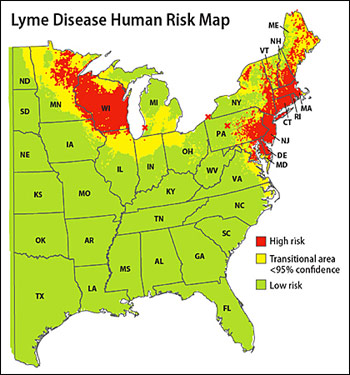Lyme Disease
Lyme disease is an illness that may affect the skin, joints, nervous system, heart, and other areas of the body. People of all ages can get Lyme disease, which is caused by the bacteria, Borrelia burgdorferi. The bacteria is transmitted to humans and some domestic animals by the bite of an infected deer tick. The deer tick – Ixodes scapularis – is also called the black legged or bear tick.
Areas of highest risk of Lyme Disease in Minnesota

The Deer Tick

Larva – The eggs hatch into tiny larva, which may become infected from the first meal.
Nymph – Most cases of Lyme disease are caused by the nymph, which looks like a freckle or speck or dirt. The nymph feeds from May through August.
Adult male and female – The larger adult ticks feed in late fall and early spring, but are easier to see and remove. After feeding on deer, the female lays her eggs.
Engorged tick – This is the size of a fully engorged adult female deer tick.
Wood ticks- also called dog ticks, are larger than deer ticks, have white markings on their back, and do not transmit Lyme disease.
How to Prevent Lyme disease
- Create a tick barrier. Wear closed shoes and long pants to reduce exposed skin. Tuck your shirt into your pants and tuck your pants into your socks or boots. Light-colored clothing allows you to see ticks.
- Use tick repellents containing permethrin, such as Permanone and Duranon, over your clothing. When ysing DEET-containing products (Diethyl-meta-toluamide), be sure to use a product containing no more than 30% DEET. No matter what product you use, follow the manufacturer’s directions.
- Walk in the center of the trail to avoid picking up ticks form grass and brush.
- After enjoying the outdoors, promptly check yourself for ticks, shower and vigorously towel dry.
How does Lyme disease spread?
- The bacteria must be transmitted by an infected tick. Fortunately, not all ticks are infected and the tick must remain attached for 24-48 hours to spread the disease. Sometimes it is hard to see these small ticks – especially immature ticks. This is why it is important to inspect yourself after you have been outdoors.
Tick Removal
The risk of getting a tick-borne disease is small if the tick is removed soon after it becomes attached.
- Use tweezers to grasp the tick close to its mouth where it is attached
- Gently and S-L-O-W-L-Y pull the tick outward in one smooth movement
- Do not squeeze the ticks body – to avoid contact with the bacteria, if present
- Apply an antiseptic to the bite
- Watch for early signs and symptoms of Lyme disease, ehrlichiosis and babesiosis
Signs and Symptoms of Lyme disease
Early Signs - symptoms of Lyme disease appear 3-30 days after a tick bite (see you physician immediately!).
- expanding rash: The most common sign is an expanding rash. This can be a solid red patch or have a bull’s-eye appearance as it clears. It is usually not painful or itchy, buy may become very large in size. Not everyone with Lyme disease gets the rash.
- muscle & join pain
- fever & chills
- headache
- vomiting
- fatigue
- enlarged lymph nodes
Early disseminated signs – days or weeks after exposure
- multiple rashes
- paralysis on one side of the face
- fever
- stiff neck
- headache
- weakness, numbness or pain in the arms or legs
- irregular heartbeat
- persistent weakness or fatigue
Late disseminated signs – months or years after exposure
- Chronic arthritis in one or more joints, usually the knees, which may be enlarged and painful
- nervous system dysfunction
- persistent weakness or fatigue
- severe cases can cause debilitation and permanent injury
Other Tick-Borne Diseases
Two diseases which appear to be less common than Lyme disease are Human Granulocytic Ehrlichiosis (HGE) and Babesiosis
Human Granulocytic Ehrlichiosis (HGE)
Less frequent symptoms of ehrlichiosis include nausea, vomiting, loss of appetite, weight loss, abdominal pain, cough, diarrhea, aching oints and change in mental status. Ehrlichiosis is treated with antibiotics.
- Fever (over 102)
- Severe headache
- Chills and shaking rigors
- Muscle aches
Babesiosis
Symptoms usually go away without treatment, but some cases may be severe. Babesiosis is treated with antimicrobial drugs.
- High fever
- Chills
- Headache
- Muscle aches
- Fatigue
- Loss of appetite
If you think you have been exposed to a tick or develop any of these symptoms, call you health care provider for advice.
For More Information
 Minnesota Department of Health, Infectious Disease Prevention & Control
Minnesota Department of Health, Infectious Disease Prevention & Control
www.health.state.mn.us/lyme
Signs and symptoms, diagnosis, treatment and prevention of lyme disease, ehrlichiosis and babesiosis, call the Minnesota Department of Health at (612) 676-5414.
Deer ticks and camping, hiking and recreational areas, call the Minnesota Department of Natural Resources at 1-800-766-6000.
Contact Us
[email protected]
[email protected]
(218) 335-7418
| Name | Title | Phone |
|---|---|---|
| Karnes, Keith | Forester | 335-7418 |
| Hare, Dave | Forestry Technician | 335-7407 |
| Haugen, Patrick | Forestry Technician | 335-7407 |
| Oxford, Jimmy | Forestry Technician | 335-7407 |
| Northbird, Mike | GAP Coordinator | 335-7434 |
| Masten, Mike | GAP Technician | 335-7434 |















 Division of Resource Management
Division of Resource Management